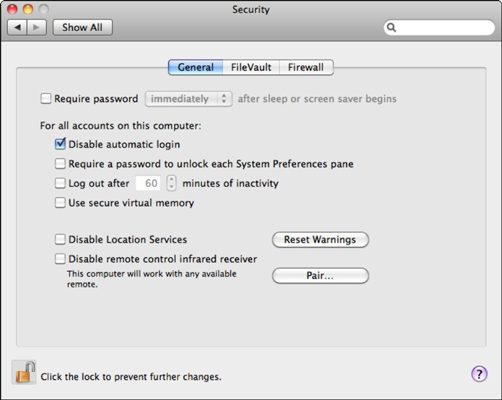We design Mac hardware and software with advanced technologies that work together to run apps more securely, protect your data, and help keep you safe on the web. And with macOS Big Sur available as a free upgrade, it’s easy to get the most secure version of macOS for your Mac.*
Feb 23, 2016 System Preferences, a built-in macOS application analogous to Settings on the iPhone, iPod touch and iPad, lets you customize the Mac to your liking. You can, for example, adjust the size and location of the Dock, change your desktop background, set your computer’s clock to a different time zone, add or remove user accounts, dive deep into. After Effects for Mac Download. If you plan to create visual effects and motion graphics for web pages, videos, television, or movies, then Adobe After Effects for Mac version will certainly interest you. This software is in demand among both large studios and individual artists. Below you will find a clear explanation of how to download this. May 07, 2020 Software & Apps. Get to Know Your Mac’s System Preferences. Posted on May 7th, 2020 by Kirk McElhearn There are lots of settings, preferences, and options on the Mac, and many of these settings are organized in one app: System Preferences.
Apple M1 chip.
A shared architecture for security.
The Apple M1 chip with built-in Secure Enclave brings the same powerful security capabilities of iPhone to Mac — protecting your login password, automatically encrypting your data, and powering file-level encryption so you stay safe. And the Apple M1 chip keeps macOS secure while it’s running, just as iOS has protected iPhone for years.
Apple helps you keep your Mac secure with software updates.
The best way to keep your Mac secure is to run the latest software. When new updates are available, macOS sends you a notification — or you can opt in to have updates installed automatically when your Mac is not in use. macOS checks for new updates every day and starts applying them in the background, so it’s easier and faster than ever to always have the latest and safest version.
Protection starts at the core.
The technically sophisticated runtime protections in macOS work at the very core of your Mac to keep your system safe from malware. This starts with state-of-the-art antivirus software built in to block and remove malware. Technologies like XD (execute disable), ASLR (address space layout randomization), and SIP (system integrity protection) make it difficult for malware to do harm, and they ensure that processes with root permission cannot change critical system files.
Download apps safely from the Mac App Store. And the internet.
Now apps from both the App Store and the internet can be installed worry-free. App Review makes sure each app in the App Store is reviewed before it’s accepted. Gatekeeper on your Mac ensures that all apps from the internet have already been checked by Apple for known malicious code — before you run them the first time. If there’s ever a problem with an app, Apple can quickly stop new installations and even block the app from launching again.
Stay in control of what data apps can access.
Download System Preferences For Mac 10.13.6
Apps need your permission to access files in your Documents, Downloads, and Desktop folders as well as in iCloud Drive and external volumes. And you’ll be prompted before any app can access the camera or mic, capture keyboard activity, or take a photo or video of your screen.

FileVault 2 encrypts your data.
With FileVault 2, your data is safe and secure — even if your Mac falls into the wrong hands. FileVault 2 encrypts the entire drive on your Mac, protecting your data with XTS-AES 128 encryption. Mac computers built on the Apple M1 chip take data protection even further by using dedicated hardware to protect your login password and enabling file-level encryption, which developers can take advantage of — just as on iPhone.
Designed to protect your privacy.
Online privacy isn’t just something you should hope for — it’s something you should expect. That’s why Safari comes with powerful privacy protection technology built in, including Intelligent Tracking Prevention that identifies trackers and helps prevent them from profiling or following you across the web. A new weekly Privacy Report on your start page shows how Safari protects you as you browse over time. Or click the Privacy Report button in your Safari toolbar for an instant snapshot of the cross-site trackers Safari is actively preventing on that web page.
Automatic protections from intruders.
Safari uses iCloud Keychain to securely store your passwords across all your devices. If it ever detects a security concern, Password Monitoring will alert you. Safari also prevents suspicious websites from loading and warns you if they’re detected. And because it runs web pages in separate processes, any harmful code is confined to a single browser tab and can’t crash the whole browser or access your data.
Find your missing Mac with Find My.
The Find My app can help you locate a missing Mac — even if it’s offline or sleeping — by sending out Bluetooth signals that can be detected by nearby Apple devices. These devices then relay the detected location of your Mac to iCloud so you can locate it. It’s all anonymous and encrypted end-to-end so no one — including Apple — knows the identity of any reporting device or the location of your Mac. And it all happens silently using tiny bits of data that piggyback on existing network traffic. So there’s no need to worry about your battery life, your data usage, or your privacy being compromised.
Keep your Mac safe.
Even if it’s in the wrong hands.
System Preferences Download
All Mac systems built on the Apple M1 chip or with the Apple T2 Security Chip support Activation Lock, just like your iPhone or iPad. So if your Mac is ever misplaced or lost, the only person who can erase and reactivate it is you.
macOS Security
- Ensure your CAC reader works with Mac
- Check to ensure your Mac accepts the reader
- Check your Mac OS version
- Check your CAC’s version
- Update your DOD certificates
- Guidance for Firefox Users
- Look at graphs to see which CAC enabler to use
Step 1: Purchase a Mac Friendly CAC Reader
Purchase a CAC reader that works for your Mac. There are only a couple that you can choose from and I’ve listed them below.
If you already have a CAC reader and it isn’t Mac friendly, you could update the firmware, however, for the non-tech savvy people out there, it’s probably better to just purchase a new one and save the headache – they’re only ~$11-13 dollars.
Best Mac Compatible CAC USB Readers
Best Mac Compatible CAC Desk Readers
Step 2: Plug in and Ensure It’s Accepted
Once you have your CAC reader, plug it into your Mac and ensure your computer recognizes it. If you have one of the CAC readers we suggested above, then you should be good to go.
If for some reason your CAC reader isn’t working, you may need to download the appropriate drivers for your CAC reader. You can find these drivers on the Reader’s Manufacturer Website.
Step 3: Update Your DOD Certificates
System Preferences On Mac
Now that you have your CAC reader connected and accepted on your Mac computer, it’s time to ensure you have the right certificates in order to access DOD CAC required web pages.
Procedure for Chrome and Safari
- Type ⇧⌘U (Shift + Command + U) to access your Utilities
- Find and Double click “Keychain Access”
- Select “Login” and “All Items”
- Download the following five files and double click each once downloaded so as to install in your Keychain Access.
- When you double-click the Mac Root Cert 3 and 4, you’ll need to tell your browser to always trust them. Click the button like you see below:
Additional Steps for Firefox
If you’re using Mozilla Firefox as your primary browser, you’re going to need to perform some additional steps. First, perform the same steps that you did for Chrome and Safari. Afterwards, follow these additional steps to get started.
*If you’re having issues downloading the zip file below, try right clicking the link and opening the file in a new tab.
- Download All Certs zip and double click to unzip all 39 files
- While in Firefox, click “Firefox” on the top left, then “Preferences”
- Then Click “Advanced” > “Certificates” > “View Certificates”
- Then Click “Authorities” and then “Import”
- Import each file individually from the “AllCerts” folder. When you do this, the below box will popup. Check all three boxes and click “OK”
Step 4: Download and install CAC Enabler
Choosing the right CAC enabler can be pretty tricky. It all depends on what OS you have installed, how you installed it, and even what kind of CAC Card you have!
In order to get the right enabler, be sure to visit our trusty guide to Mac CAC Enablers! It’ll walk you through exactly which enabler is right for you.

CAC Access at Home Success
Now that you have a CAC reader, certificates, and a CAC Enabler, you should now be able to access any CAC-enabled website and log on using your CAC password and data.

Common Reasons Why Your CAC Card Won’t Work On Your Mac
Ensure Your CAC Card Meets the Standards: In order for your CAC card to work, it must meet the minimal requirements. Currently, there are only four types of CAC cards that can be used. The ensure you have the right CAC card for online access, flip your CAC card to the back and if you have one of the below numbers written on the top left, then you are good to go:
- G&D FIPS 201 SCE 3.2
- Oberthur ID one 128 v5.5 Dual
- GEMALTO DLGX4-A 144
- GEMALTO TOP DL GX4 144
If you do not have any of the above written on the back, then proceed to your nearest PSD to get a new CAC card issued.